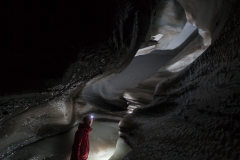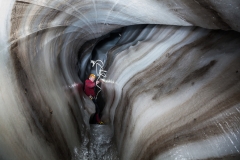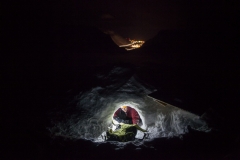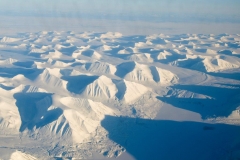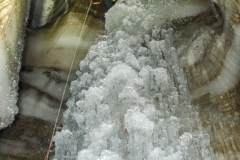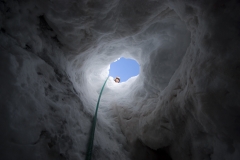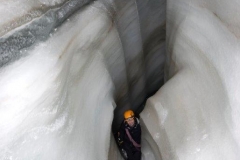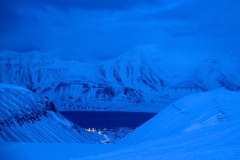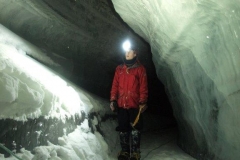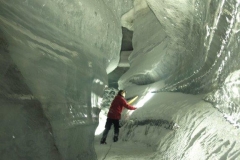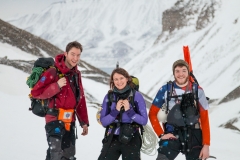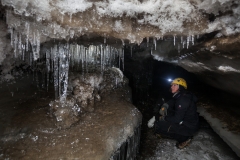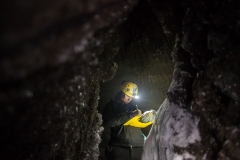E5 – Journey to the Center of the Ice
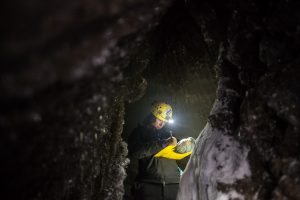
Kiya sketches the shape of the channel in front of her. The team uses standard limestone mapping techniques to map these glacial cave systems.
Credit: Ethan Welty.
From the outside, glaciers appear to be solid masses of unmoving ice. But meltwater flowing from the surface down to the glacier bed carves canyons, gorges and even caves into the dense sheets of ice. Over time, the fissures form labyrinthine tunnels that open into vast ice caverns few people have ever seen.
University of Oregon glaciologist Kiya Riverman is one of a handful of researchers who ventures into this frozen world of glacier ice caves. What started as a hobby exploring limestone caves in Pennsylvania has become an area of scientific exploration for Kiya, who makes hand-drawn maps of these cave systems and tracks how they change over time. In this episode, listen to Kiya describe what it’s like to rappel down a frozen waterfall, crawl through tiny ice passages and do science 1840s-style.
Read more about Kiya’s work on Eos.org and watch a video of her exploring an ice cave in Svalbard on AGU’s YouTube channel.
This episode was produced by Lauren Lipuma and mixed by Kayla Surrey.
Episode Transcript
Shane Hanlon: Hi, Nanci.
Nanci Bompey: Hello, Shane.
Shane Hanlon: All right. So, today’s question of the day: If money or resources or whatever weren’t an issue, like if you could do whatever you wanted, what’s the craziest place on Earth that you would want to visit?
Nanci Bompey: Craziest place? I don’t know where the craziest place … I think it would have to be kind of warm. But as you probably know, I love reading, and I would love to go to a place where there were lots of bookstores, that I could just stay in all day, and just read books, like on a remote island. I think there actually is one somewhere. They have an outdoor bookstore somewhere. You know what I mean? Like, in a tropical place. I follow it on Instagram. It looks pretty sweet.
Shane Hanlon: Only you would answer, “I want to go to an island and …” It sounds amazing, but that wasn’t exactly … Hey, you do you.
Nanci Bompey: So, what about you, then?
Shane Hanlon: I think mine would probably be the opposite. I mean, reading is fine, but I’d want to go probably somewhere cold. I know a lot of … I actually have a few friends who have been down to Antarctica, and that seems so hot right now. But I’d want to go probably north. I don’t know. I’ve been thinking about maybe Greenland in the middle of winter. I want to be somewhere where I can ski, and snowshoe, and ride snowmobiles, and be around snow.
Nanci Bompey: That would be pretty sweet.
Shane Hanlon: Yeah.
Nanci Bompey: So, have you heard of this place called Svalbard?
Shane Hanlon: Heard of, but I can’t exactly say it’s been on my radar. Welcome to the American Geophysical Union’s podcast about the scientists and the methods behind the science. These are the stories you won’t read in a manuscript or hear in a lecture. I’m Shane Hanlon …
Nanci Bompey: And I’m Nanci Bompey …
Shane Hanlon: And this is Third Pod from the Sun. So, why Svalbard?
Nanci Bompey: Well, let’s bring in our producer, Lauren Lipuma to explain. Hey, Lauren.
Lauren Lipuma: Hey, guys.
Shane Hanlon: Okay, so, I’ll ask you. Why Svalbard?
Lauren Lipuma: Well, a few months ago, I met Kiya Riverman, who is a glacial researcher at the University of Oregon, and Kiya studies caves in, guess where? Svalbard. Svalbard is a group of islands in the Arctic Ocean, kind of between Norway and the North Pole. It seems like a random place, but people live there, and there’s actually a university where people do research.
Speaker 4: [00:02:30] Did you guys engage your ice feet?
Kiya Riverman: I, as an undergraduate, studied abroad up in Svalbard, and was interested in doing some glaciology research, and went to the main professor at the university there at the time. I said, “Hey, how can I help?” And he looked at me, and was like, “Yeah, you’ll fit.” Which I didn’t understand at the time, but as it turns out, there was this cave system that he was doing a lot of work in, that there was this one really tight spot that he couldn’t actually fit through, and so he was looking for people who could help with the project. So, that was my first time down in, and it was kind of the opening of a whole new world of research to me.
It’s at 79 … 78, 79 degrees north, so it’s super high Arctic. So, that means that there’s 24-hour daylight, and there’s 24-hour night time, and then transitions between them. And so, I first went up there in the dark. I couldn’t see anything, and all we got was these magnificent displays of northern lights and stars, and then the light slowly started to come back, and you could see these huge mountains all around. And it was like the awakening of this beautiful arctic landscape.
And it’s a little community up there, so the second you step outside of town, you’re in this vast, untouched arctic landscape that has so many exciting research questions and research avenues to go down, and so that combination for me was just addictive, almost.
Shane Hanlon: Where are these caves she’s talking about?
Lauren Lipuma: They’re caves made of ice inside of a glacier.
Shane Hanlon: What? Wait. She goes in there? Why would someone ever go inside an ice cave inside a glacier?
Lauren Lipuma: Well, that’s one of the ways to study how water flows through a glacier from the top to the bottom.
Kiya Riverman: So, to study water under the ice, I go out to the middle of Greenland and Antarctica and blow up dynamite, and measure vibrations that come back from the underside [inaudible 00:04:37]. If I care about water on top of the ice, then I usually use satellite imagery. If I care about how water gets from the surface of the ice to underneath the ice, then I crawl around inside of glaciers, and kind of study the ice from the inside out and look at the pathways that the water actually takes as it moves through the ice.
Water, as it’s cutting through ice, it forms these big, tall canyons, and then those canyons start to close above, in the ceiling. So, you walk and crawl through this kind of teardrop-shaped passage that is beautiful, in a really otherworldly way. And I spend a lot of time studying the waterfalls, actually, that are within that system.
So, as it turns out, waterfalls matter inside of these glaciers. They’re one of the big ways that the system changes, in the way that water is transported from the surface of the ice to underneath. And so, I spend a lot of time roped up in a harness, kind of hanging off of these waterfalls, taking pictures, and mapping where they are, and it’s lovely.
Shane Hanlon: So, she’s an ice caver. How does one go about becoming such a thing?
Lauren Lipuma: Well, Kiya did some caving in normal limestone caves back in Pennsylvania, your neck of the woods, Shane.
Shane Hanlon: Woohoo!
Lauren Lipuma: But these glacier caves are different because they’re ice and not rock.
Kiya Riverman: When you’re caving in a limestone environment, being cold isn’t such a concern. It’s more like you’re really warm, and you have to manage that. But we actually have to pretty actively manage our own temperature inside of these systems. So, maybe that’s the obvious difference, but there are a lot of similarities, and I think I’m forever surprised by the similarities. Because you see a lot of the same formations of meltwater dripping and freezing that look exactly like limestone formations, and so it’s kind of just like a muddy limestone world has all just been frozen into ice, and the comparison is more striking than the differences, I think.
There are specific places where the environment is such that you form these systems, and Svalbard is one of the big ones, and so there hasn’t been as much work done really anywhere else. I would love to go to the Himalaya and crawl around inside of glaciers there. Maybe someday.
Nanci Bompey: So, what’s a typical day like for her down there?
Lauren Lipuma: Well, the first thing she has to do is get to the cave, which means she has to ski up the glacier to the cave’s entrance, and then she climbs in and down.
Kiya Riverman: A day starts, you strap on your skis, you ski up the hill, you leave everything outside, and then you drop into the cave. I always love that moment, because it’s this transition from this brutal arctic environment to quiet, warmer cave, where it’s like we can sink into the beauty of it and the science of it, and all of the distractions of the hazards of the arctic environment, otherwise, just go away.
Lauren Lipuma: What does it kind of look like when you’re in there?
Kiya Riverman: Imagine a cave that you would see in the limestone world, with stalagmites and stalactites, but then change all of that to ice. So, you’re in [00:08:00] an ice cavern, and the walls are sometimes sparkly, where you get air movement, and you can see your breath in front of you always. You can see layers in the glacier, actually, so you can tell a little bit of its formation history and flow history, just by seeing where is it deformed, and how is the ice flowing? It’s lovely.
We’re actually building maps by hand of these cave systems. There’s not a lot of technology that works very well inside of these cave systems. Things like to freeze and break, and so what we’ve found, kind of by a lot of trial and error, is that we do science in a very 1840s style, which is mostly hand-sketching, to scale, these systems.
Lauren Lipuma: Do you have to be a good artist?
Kiya Riverman: I don’t know if I would claim to be a good artist. But there’s a little bit of being able to represent, to scale, what you’re seeing in the environment, that definitely comes into play.
Lauren Lipuma: Yeah.
Kiya Riverman: We actually do use laser rangefinders to get distances between points, and angles, to make sure everything we’re doing is to scale. But then we travel through the system, and sketch it as I go. And I’ve worked with people who also do structure from motion photography, which is, you take a picture of an object from a bunch of different angles, and then use that to make a 3D point cloud that lets you later go in and do a lot more kind of detailed analysis of the system. But even that sometimes doesn’t go very well, so we always come back to these hand-drawn sketches, which we can go in and digitize them, and then compare year after year, how is this system changing?
Lauren Lipuma: How long will you spend down there each time you go in?
Kiya Riverman: Usually, it depends on how long you can stay warm. So, sometimes we go in for four hours, and can get done what we need to do, and then there have been times that we’re spending 17 hours down in there. And then after that, it’s always a real shock to climb back out and see that it’s night time, and you have to ski down the glacier again.
Lauren Lipuma: Is there any time you’re up there where you’re just like, “It’s so cold, I have to get out of here. So cold and so dark, I have to get out of here now.”
Kiya Riverman: Yeah, but then as soon as you get out, you have a beautiful ski back down the glacier, and it lifts your spirits right back up again.
Shane Hanlon: Does she go all the way to the bottom of the glacier? I mean, what is that like?
Lauren Lipuma: Well, yeah, she does, actually. This particular glacier in Svalbard is about 60 meters thick. That’s about 200 feet. So, she and her colleagues, they climb all the way down that 200 feet to the bottom, which is the bed of that glacier.
Kiya Riverman: Glaciologists spend a lot of time trying to study the bottom side of glaciers.
Speaker 6: [00:11:00] Oh, look at this.
Kiya Riverman: And it’s so hard to do. You can imagine, in most places, you’re standing on the top of this ice, and in Antarctica, there’s a mile of ice between you and the bed. How do you actually study down there? And that’s one thing I love about this work, is we can actually go there, and take samples, and do measurements. That’s just a unique privilege, that it’s easier to think about when you’re not army-crawling through rocks under the ice. But when you get out later, to marvel in, kind of, the opportunity to study them from the underside.
Lauren Lipuma: When you’re down there at the bottom, do you ever feel claustrophobic in a way, and you’re like, “Oh my god, there’s tons and tons of ice sitting on top of me right now.”
Kiya Riverman: Yeah. Only when I start thinking about how the channels are actively closing. Like, even while you’re there, the ice is always creeping closed, just at a really slow rate. But there are moments where you squeeze through something small, and that part of your brain is like, “Oh man, I know it’s closing.” But, I mean –
Lauren Lipuma: It’s not going to close on you.
Kiya Riverman: It’s not going to close on you. It’s not fast enough to ever be a concern. But some little part of your brain is like, “Oh, it’s still closing. Maybe I shouldn’t spend all day down here.” I think there’s a fear. I think people are scared of the idea of going into and underneath these glaciers. But we know how to be safe in them, and so that means it’s not a scary place. It’s just a real opportunity to study these beasts from the inside out.
Nanci Bompey: So, how many times has Kiya been down inside this glacier?
Lauren Lipuma: She’s been to this glacier four times in the last eight years, and she’s actually seen it change quite a bit.
Kiya Riverman: That’s one of the nice things about going back regularly, is that kind of on a year-by-year scale, you can stand in the same point and go, “Oh, last year, the cavern had this shape, and now I can see exactly how it’s changed this year.” And the overall trend that we’re seeing is that the waterfalls are growing together and getting bigger. Over time, they start really small, and then they grow bigger and cut in faster to the ice. And that could be due to more water entering the system, so more melt is occurring, or it could just be part of kind of a cycle of these channels forming and evolving, and then closing over time.
Lauren Lipuma: And what will that tell you about how the glacier is changing?
Kiya Riverman: Where you can find water under the ice, that water has an impact on the way that the ice flows. You can imagine, a wet ice cube sitting on a table is going to slide around a whole bunch, and a dry one just sits there. And really, what I’m doing is showing, where does water that we see on the surface of the ice, and we see it dropping into this system, where is that actually coming into contact with the bed? And so, by mapping over time where that point is, it tells us how this glacier, how its flow in the future might change. Because if the area downstream of wherever the water is reaching the bed is able to flow faster, we’re showing how that point is progressing through space.
Nanci Bompey: This sounds so super cool and adventurous. Has it inspired Kiya to do other really super adventurous things?
Lauren Lipuma: Yeah. I don’t know how you would get more adventurous than ice caves, but she told me she has become kind of a mountaineer.
Kiya Riverman: My partner and I spend a lot of time doing mountaineering and skiing, and recently we got into canyoneering, in Utah, mostly. There are these canyons that remind me so much of ice caves, actually, because they have the same kind of layering that you see in the walls, and very similar morphology, or shape of the canyon. And it was fun to go do this canyoneering, and realize that my skills that have come from years of ice cave work could translate to this fun, new sport. So, yeah, it definitely has influenced the rest of my life.
Lauren Lipuma: Oh, that’s so cool. So, which one is more difficult, then?
Kiya Riverman: I think ice caving wins for the cold factor.
Lauren Lipuma: Yeah.
Kiya Riverman: Plus, it’s really novel to, in canyoneering, be able to not have a headlamp. It’s like the best of caving and rock climbing combined, because you can see what you’re doing.
Lauren Lipuma: What’s your favorite thing about doing this kind of work?
Kiya Riverman: This has always kind of been a side project for me. My PhD was based on studying ice streams in Greenland, and how they move and change, and this has always been a fun question on the side that is like my own ideas. So, it’s not like I have an advisor who’s giving me projects. It’s been just my own … Getting to do science, getting to ask questions, and then go pursue them, and write grants, and get them funded. I think, even as an early grad student, to have that experience of being able to ask my own questions, and make it happen, and do the fieldwork, and work on publishing the results, it’s been really empowering.
Lauren Lipuma: I have a confession, guys. I thought Svalbard was a made up place until about a year ago.
Shane Hanlon: Well, I mean, I can barely pronounce Svalbard, so.
Nanci Bompey: Why did you think it was made up?
Lauren Lipuma: Because a long time ago, I read the “Golden Compass,” which takes in an alternate universe, and they go to Svalbard, and so I just thought it was an island made up for that book. I didn’t think it was a real place where people lived.
Nanci Bompey: That makes sense. That makes sense. Maybe you could read that book about Svalbard in a remote bookstore on an island with me!
Shane Hanlon: Oh, my gosh. Oh, Nanci.
Lauren Lipuma: I’d rather just go to the beach, Nanci, if that’s okay.
Shane Hanlon: All right, folks, that’s all from Third Pod [00:17:00] from the Sun.
Nanci Bompey: Thanks, Lauren, for bringing us this story, and to Kiya for sharing her work with us.
Shane Hanlon: This podcast is also produced with help from Josh Speiser, Olivia Ambrogio, Caitlyn Camacho. And thanks to Kayla Surrey for producing this episode.
Nanci Bompey: AGU would love to hear your thought on this podcast. Please rate and review us, and of course, you can always find new episodes at your favorite podcasting app, or at ThirdPodFromTheSun.com.
Shane Hanlon: Thanks, all, and we’ll see you next time.

